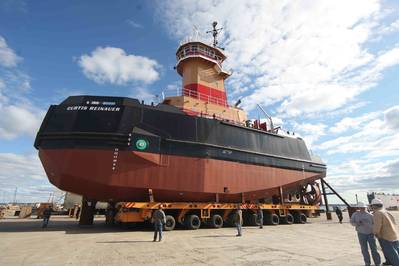A Boon to Shipbuilding
Detailed Instructions and Sequencing of Tasks
Having detailed instructions for each shipbuilding task and precise sequencing of the workflow is creating efficiencies and reducing rework at shipyards on the east and west coasts of the US.
The work packs that Senesco Marine’s tradesmen are working from provide instructions—including checks and balances and dimensions—for each step of the process. “The person cutting the angles to go on panels has a cut sheet with instructions on how to cut every angle,” explains Joe Bush, VP Operations at Senseco Marine in North Kingstown, Rhode Island. Senesco is a builder of double-hulled barges, tugboats, and other vessels. “The guy welding plates together has a set of dimensions that tells what all the parameters of the plate should be after welding,” he adds, “and there are marks indicating where to lay those angles from the edge of the plate.”
The 2D drawings they used previously “left some things open to interpretation,” observes Bruce Kintner, Senesco’s Engineering Manager, who adds they relied on experienced shipwrights. Now they have a 3D isometric view of every frame and panel, with additional views that include every part and bracket once it is added. “You don’t have the ability to envision what a 3D panel is going to look like from a 2D drawing,” Kintner notes. Five years ago, Senesco transitioned from a firm that created product models from a 2D lofting package and began working with Genoa Design International Ltd. of St. John’s, Newfoundland. Genoa creates 3D product models using Ship Constructor. These models include every plate, bracket, bar, angle, and penetration in the entire build, says Kintner, who adds that due to the level of detail and precision in the instructions, experienced shipbuilders are no longer required in the ship construction process.
On the first two 100,000-barrel barges Senseco built for Reinauer Transportation of Staten Island (Reinauer acquired Senesco in 2006), Bush reports that using the 3D product model enabled a nearly 95 per cent reduction in rework. He adds that another plus from the new system is that it provides Senesco’s quality control department with all of the lengths, breadths, and cross-dimensions of the project. Overall, he says using the current system “helped us move closer to being competitive with the bigger yards.” Kintner adds that it has also helped reduce the amount of overtime that is required to stay on schedule.
Currently, Senseco is building three tugboats and a 100,000-barrel barge for Reinauer, and a 420-foot by 120-foot drydock for Caddell Drydock and Repair Co. of Staten Island.
Seattle-based US Fab, the new construction division of Vigor Industrial, began using 3D product models from Genoa Design in early 2012. Kevin Hein, US Fab’s Director of Engineering, notes that the drawings are sequenced to reflect the intermediate work products and the order in which the work progresses through the vessel, such as the installation of a hanger bracket, a hanger, and then a pipe—if it can be installed early. Sometimes the sequencing is counterintuitive, such as waiting until later in the process to install the foundation that goes around a pipe. All the hotwork is normally done together, at an earlier stage, he explains). “In the more conventional approach, all of the pipe in the system is shown on the deck on a specific level,” he notes, “and they tell you to go install it.”
The sequencing of tasks allows for welding in the downhand position, Hein adds, as opposed to having to weld overhead, resulting in three to five times greater efficiencies. The early definition of materials and their location also enables electrical subcontractors to install the hangers for the wireways before the steel has left the shop.
Hein notes there has been a reduction in rework since US Fab began using this system, and he cites interference checking as an additional benefit. “Genoa uses software tools to the greatest extent they can,” he says, “which automates the process of checking to see if a piece of pipe is interfering with another piece of pipe or 3D object. They’ve designed a process that minimizes interference, and then they use automation to wade through the remaining interference. This use of automation complements the use of talented and experienced designers who can then focus on other areas rather than some of the monotonous tasks.”
US Fab is currently working with Genoa on a 362-foot ferry (83-foot beam) for the Washington State Department of Transportation (Washington State Ferry system) that is rated to carry 144 cars and 1,500 passengers.
The way Genoa Design’s president, Leonard Pecore, describes their process, naval architects and marine engineering systems design technologists build the vessel in 3D (“the product model”) on the computer. This contains geometric information, build strategy, tooling information, and vendor information. The company’s key differentiator, he adds, is the application of Toyota’s lean manufacturing principles to shipbuilding, internally as well as externally in the methodology that is passed along to clients. Efficiencies, he says, are evidenced in cost savings, higher quality, workflow, and reduction of waste. Analyzing the most efficient sequence for putting the ship together is key. They may use one less letter, for example, when numbering a part. “It saves two seconds each time the part is cut,” Pecore says, “but if there are 5,000 of those parts, that’s 10,000 seconds (2.75 hours).” From their St. John’s office, Genoa creates product models of tankers, tugs, ferries, barges, towboats, offshore supply vessels, icebreakers, and military vessels.
(As published in the December 2012 edition of Maritime Reporter - www.marinelink.com)














